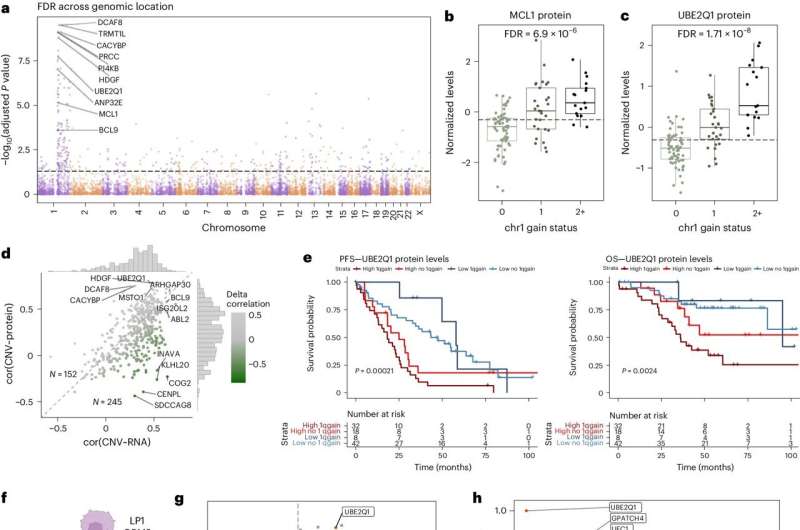This article has been reviewed according to Science X's editorial process and policies. Editors have highlighted the following attributes while ensuring the content's credibility:
fact-checked
peer-reviewed publication
trusted source
proofread
Multiple myeloma: New insights into early detection of aggressive tumors

Multiple myeloma is one of the most common forms of cancer of the immune cells in the bone marrow. It is considered incurable. Even when patients respond to treatment at first, the cancer comes back.
To be able to intervene faster and on a more targeted basis, researchers at Charité—Universitätsmedizin Berlin, the Berlin Institute of Health at Charité (BIH), and the Max Delbrück Center teamed up with other partners for a comprehensive study of this disease at the molecular level.
The team now describes how highly aggressive types of tumors can be detected early on in an article published in the journal Nature Cancer. They show how changes in genetic material affect the protein profile of the tumor cells, and thus the mechanisms involved in the disease.
Multiple myeloma is a form of cancer in which the immune cells in the bone marrow, known as plasma cells, mutate and become cancerous. Plasma cells are responsible for producing antibodies. All humans have many different kinds of plasma cells that form large numbers of different antibodies. This allows the body to recognize and fight various pathogens.
In multiple myeloma, a single plasma cell mutates into a tumor cell. That cell reproduces unchecked, forming a monoclonal cell population. This means many cells are formed, all of them exactly the same and genetically identical at first. The mutated cells often also produce large volumes of antibodies or fragments of them—but they do not function properly.
Over the course of the disease, most patients develop tumors at various locations in the bone marrow, hence the "multiple" in the disease's name. Immunodeficiency, kidney failure, bone loss, and bone fractures are just some of the consequences of this uncontrolled cell growth.
Despite advances in treatment and the introduction of new gene and cell therapies, there is no cure for multiple myeloma at present. With this issue in mind, a team of researchers led by Jan Krönke from the Department of Hematology, Oncology and Cancer Immunology at Charité and Dr. Philipp Mertins, head of the Proteomics technology platform of the Max Delbrück Center and BIH, set out in search of new approaches to diagnosis and treatment.
What path does the tumor take?
No two cases of cancer are alike, and multiple myeloma is no exception. Tumors develop differently in different individuals, including at different rates. This makes it more difficult to predict how the disease will progress and choose the optimum treatment. While the mutated plasma cells do not spread much in some cases, in others they are extremely aggressive, leading to a poor prognosis.
But what causes so much divergence in the course of multiple myeloma? In cooperation with protein analysis experts from the Max Delbrück Center and BIH, the researchers conducted a detailed study of genetic and molecular changes occurring in the tumor cells in a group of more than one hundred patients.
The study included data from patients in the German Multiple Myeloma Study Group (DSMM), which is coordinated by the University Hospital of Würzburg. This allowed the researchers to include clinical data on patients who had received standardized treatment over a period of eight years or more following initial diagnosis.
Systems medicine and big data
While changes in the genome and their effects on the proteome are already well described for other types of cancer, this is the first detailed proteo-genomic study of multiple myeloma.
"Genetic data alone is insufficient to explain the mechanisms involved in this disease," Mertins says. "We wanted to know the consequences of genetic changes at the protein level and compare this molecular biology data against the actual course of the disease in patients."
The team was supported in collecting and analyzing the large volumes of data by experts at Charité, BIH, and the German Cancer Consortium (DKTK).
Cutting-edge mass spectrometry methods made it possible to map the protein profile of mutated plasma cells and compare it against that of healthy plasma cells in people without the disease. The researchers found that both genetic changes and changes in signaling pathways lead to uncontrolled activation of cancer cells. Regulatory processes at the protein level had the stronger influence.
The researchers identified a protein constellation that suggests the disease will take a particularly aggressive course, regardless of other known risk factors.
Unlocking new therapies
"Our findings will help subcategorize patients more effectively going forward, personalizing their treatment," Krönke concludes. "We've identified key proteins and signaling pathways that can serve as the basis for even more effective, better tolerated treatments for multiple myeloma, for example for immune therapies such as CAR T-cell therapy."
In further steps, the researchers plan to study which of the target structures they have identified are in fact good candidates for new therapeutic approaches.
The study is a crucial resource for research and applied development, says Dr. Evelyn Ramberger, first author of the study. She says, "To make the complex data set manageable, we programmed an interactive, freely available online tool."
This has given cancer researchers easy access to the results, so they can use the information to develop new therapies and tests to help guide treatment. For example, it may be possible to treat patients with an especially aggressive form of multiple myeloma with more intensive therapies right at the outset.
More information: Evelyn Ramberger et al, The proteogenomic landscape of multiple myeloma reveals insights into disease biology and therapeutic opportunities, Nature Cancer (2024). DOI: 10.1038/s43018-024-00784-3


















